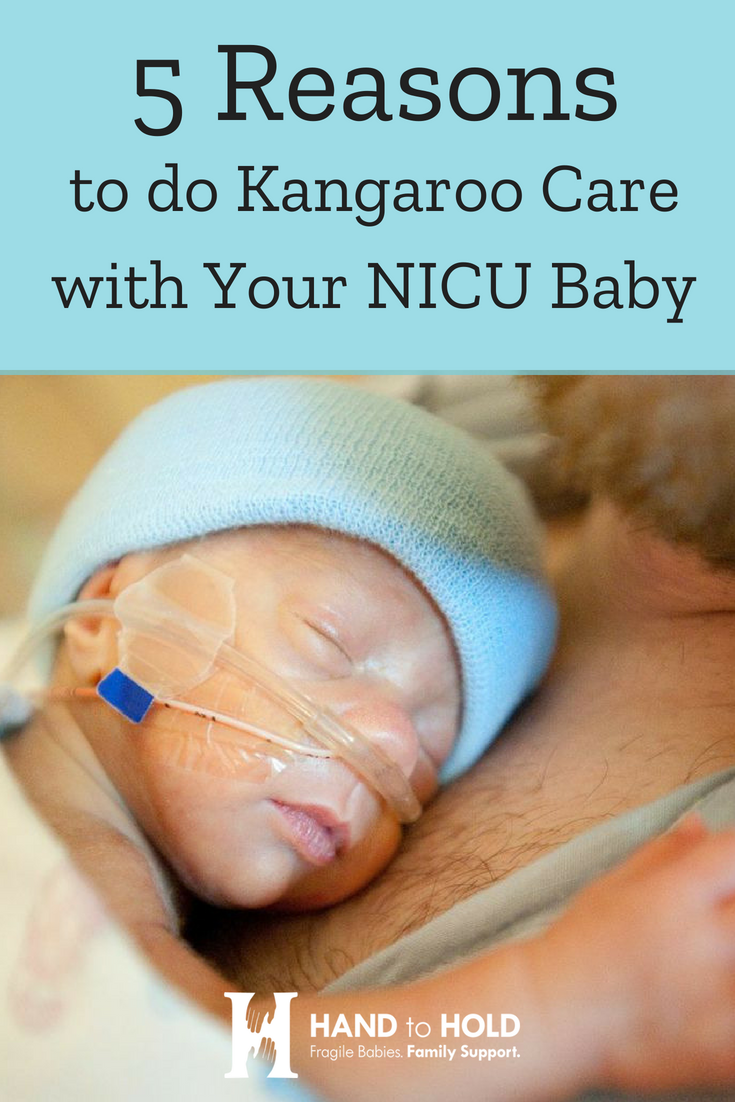
If you’re in the NICU, chances are your medical team will encourage you to participate in skin-to-skin care with your baby, also known as kangaroo care. Kangaroo care has many positive benefits for both parents and babies, could result in a shorter NICU stay, and has been shown to promote healthy brain development with long-lasting effects. Here are five great reasons you should participate in kangaroo care as much as possible.
Positive benefits for baby’s health
Holding your baby skin-to-skin helps your baby feel comfortable, safe and warm. Positive benefits for baby’s health include:
- regulation of heart rate, breathing, and temperature
- improved weight gain
- stabilized organ function
- reduced pain and crying
- and more
All of these benefits result in your baby experiencing more calm and less stress, which has been shown to lead to shorter a NICU stay.1
Read more in depth on the benefits of kangaroo care for babies and parents.
Increased breast milk production and willingness to breastfeed
Participating in kangaroo care is a great way to stimulate your milk production and facilitate a positive breastfeeding relationship with your baby. Skin-to-skin care increases the production of oxytocin, a powerful hormone that plays a role in maternal-infant bonding and milk release, among many other things.
Additionally, holding your baby skin-to-skin may increase their willingness to breastfeed when they are ready.2 Breastfeeding is a significant milestone in the NICU. Many babies can start attempting to breastfeed at 32 weeks, when they develop the reflex to suck, swallow and breathe. However, your baby may still be able to smell your milk while you’re holding her. A preemie’s sense of smell is fully developed at 29 to 32 weeks gestation, meaning they may begin to associate the smell of milk with feeding times, which can also help stimulate digestion.
Another cool fact? Studies have shown that the temperature of your breasts will actually increase or decrease in response to your baby’s temperature.
Increased bonding with both parents
Kangaroo care is an opportunity for you to take part in valuable bonding with your baby. Talk softly, sing or hum to your baby, or just sit quietly and enjoy the moment.
Dads and partners may feel like they have less of a role in the NICU. Kangaroo care empowers both parents so they feel like a significant part of their baby’s life, learning critical knowledge about caring for their baby and becoming a part of their schedule, all while building a lasting bond.
May reduce the effects of postpartum depression
Holding your baby skin-to-skin releases that powerful hormone, oxytocin, which – along with helping in milk production – has been hypothesized to reduce feelings of fear, anxiety and maternal stress in the postpartum period.
It’s important to note that kangaroo care is not a suitable substitute for the advice and care of a medical professional. If you feel you may be experiencing postpartum depression, postpartum anxiety, or post traumatic stress disorder, please contact your doctor today.
Can boost baby’s mental development
In 2016 a study revealed kangaroo care held significant, long-lasting social and behavioral protective effects.3 Newborns who experienced skin-to-skin care in the NICU were more attached and bonded to their mothers over time, were more alert after six months and their mothers were more attuned to their infant’s cues.
In early childhood, children who received kangaroo care also show increased social competence, a positive sense of self and improved cognitive and motor development. 4,5 These benefits are all signs of healthy brain development.
Sources
1 Charpak N., Ruiz-Peláez, J. G., Figueroa de C. Z., & Charpak, Y. (1997). Kangaroo mother versus traditional care for newborn infants </=2000 grams: a randomized, controlled trial. Pediatrics. 100(4):682-8.
2 World Health Organization. (1993). Kangaroo mother care: a practical guide. Retrieved July 12, 2013 from
https://www.who.int/maternal_child_adolescent/documents/9241590351/en/
3 AAP News. (2016). Twenty-year Follow-up of Kangaroo Mother Care Versus Traditional Care. Retrieved January 4, 2016, from https://pediatrics.aappublications.org/content/139/1/e20162063.
4 Neu, M. & Robinson, J. (2010). Maternal holding of preterm infants during the early weeks after birth and dyad interaction at six months. Journal of Obstetric, Gynecologic, & Neonatal Nursing, 39, 401-414; DOI: 10.111/j.1552-6909.2010.01152.x.
5 Blacke, J. & Gregson, S. (2011). Kangaroo care in pre-term or low birth weight babies in a postnatal ward. British Journal of Midwifery, 19, 9, 568-577.

